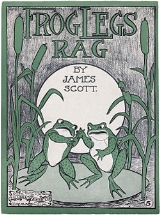
Frog Legs Rag
Encyclopedia
 |
|
|
|
"Frog Legs Rag" is a classic rag
Classic Rag
Classic Rag is a term used to describe the style of ragtime composition pioneered by Scott Joplin and the Missouri school of ragtime composers...
composed by James Scott
James Scott (musician)
James Sylvester Scott was an African-American ragtime composer, regarded as one of the three most important composers of classic ragtime, along with Scott Joplin and Joseph Lamb....
and published by John Stillwell Stark
John Stillwell Stark
John Stillwell Stark was a United States publisher of ragtime music. He is best known for publishing and promoting the music of Scott Joplin....
in December 1906. It was James Scott's first commercial success. Prior to this composition Scott had published marches. With "Frog Legs Rag", Scott embarked upon a career as a successful and important ragtime
Ragtime
Ragtime is an original musical genre which enjoyed its peak popularity between 1897 and 1918. Its main characteristic trait is its syncopated, or "ragged," rhythm. It began as dance music in the red-light districts of American cities such as St. Louis and New Orleans years before being published...
songwriter.
Background
In 1909, Scott JoplinScott Joplin
Scott Joplin was an American composer and pianist. Joplin achieved fame for his ragtime compositions, and was later dubbed "The King of Ragtime". During his brief career, Joplin wrote 44 original ragtime pieces, one ragtime ballet, and two operas...
orchestrated for "Frog Legs Rag" to be published by John Stillwell Stark, Joplin's publisher, and his company, Stark Music Company. Edward A. Berlin, author of the Joplin biography King of Ragtime: Scott Joplin and His Era asserts that there was no direct evidence that James Scott and Scott Joplin were personally acquainted. "They certainly knew each other's music," Berlin affirms while describing the Joplin orchestration, and they "had similar temperaments, both being mild-mannered, quiet, and thoroughly engrossed in their music". However, he considers assertions of personal acquaintance between the two men to be speculation.
Other music historians take a different view. The authors of Black Bottom Stump credit Joplin for discovering and mentoring the young artist "even while his [Joplin's] own career was faltering" and assert that "Frog Legs Rag" was published "at Joplin's insistence".
Structure
Ragtime encyclopedist David A. Jasen identifies a number of characteristic James Scott compositional devices in this early work.Jasen's appraisal of "Frog Legs Rag" is not unreserved: he also places "Frog Legs Rag" within the early period when James Scott compositions were "flag-waving" and lacking in the restraint the songwriter developed after 1906. Unlike Joplin, who lengthened traditional ragtime phrasing, Scott explored the genre's dynamic qualities with shortened phrasings.
Reception
Among songs published by Stark, "Frog Legs Rag" was second in sales after Joplin's "Maple Leaf Rag". "Frog Legs Rag" has been described as "brash" and "exuberant". It was also considered to be a landmark in ragtime sheet music, composed with "vigor" and "brilliance", and to be "one of the great hits of the ragtime years".External links
-
 Sheet music of Frog Legs Rag at WikisourceWikisourceWikisource is an online digital library of free content textual sources on a wiki, operated by the Wikimedia Foundation. Its aims are to host all forms of free text, in many languages, and translations. Originally conceived as an archive to store useful or important historical texts, it has...
Sheet music of Frog Legs Rag at WikisourceWikisourceWikisource is an online digital library of free content textual sources on a wiki, operated by the Wikimedia Foundation. Its aims are to host all forms of free text, in many languages, and translations. Originally conceived as an archive to store useful or important historical texts, it has...

